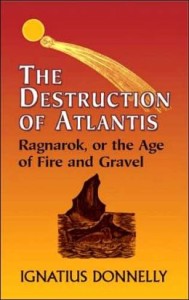YDIH
Younger Dryas Impact Hypothesis
The Younger Dryas Impact Hypothesis (YDIH) is based on the claim that around 12,800 years ago the Earth had an encounter with a very large asteroid or comet that broke up in an airburst over North America and of which some fragments possibly hit the ground directly(a).
Many effects have been linked with this event with varying levels of enthusiasm including a suggested association with the demise of Atlantis. Elsewhere, megafaunal extinctions, cataclysmic floods, the disappearance of the Clovis people and the creation of the Carolina Bays(g), have all been proposed as consequences of this episode.
In 2006, Richard Firestone, Allen West & Simon Warwick-Smith published the foundations of the YDIH in The Cycle of Cosmic Catastrophes [110]. A year later the hypothesis had a more public airing at the American Geophysical Union Press Conference, Acapulco, Mexico, on May 23(d). This was followed the same year by the publication of a formal paper in the Proceedings of the National Academy of Sciences of the United States of America(f).
Since then volumes have been written on the subject, both pro and con(c).
A 2014 paper(h) entitled Nanodiamond-Rich Layer Across Three Continents Consistent with Major Cosmic Impact at 12,800 Cal BP by Charles R. Kinzie et al., has developed further the idea of this event being associated with the Younger Dryas. In a similar vein is an article(f) from Megan Gannon.
December 2014 saw Graham Hancock raising the issue of a cometary cause for the Younger Dryas and its possible association with ancient Egypt(e).
Martin Sweatman brought further evidence to bear on this debate in an article(i) on the Graham Hancock website. This focuses on the investigations at Hall’s Cave in Texas described in a paper by Sun et al, where the team concluded that the trace elements found there could indicate a volcanic rather than an impact as the cause of the Younger Dryas cooling! Sweatman disagrees with their conclusions claiming that there seems to be an element of selectivity in choosing data, leading to a wrong conclusion.
2019 also gave us a paper that included an extensive bibliography and overview of the YDIH debate(k).
In 2020, the eminent geologist James Lawrence Powell published Deadly Voyager [1911], which offered further support to the YDIH. This book was instrumental in changing the negative stance of a number of ardent sceptics including Michael Shermer(j).
In 2022 Powell concluded a paper reviewing the YDIH debates with the following
“Finally, we can now assess Sweatman’s suggestion that the YDIH may be ready for promotion from hypothesis to the status of theory. If we combine the definitions of “theory” from the National Academy of Sciences and the American Association for the Advancement of Science, it would read something like this:
‘A scientific theory is a well-substantiated explanation of some aspect of the natural world, based on a body of facts that have been repeatedly confirmed through observation and experiment. It refers to a comprehensive explanation of some aspect of nature that is supported by a vast body of evidence. One of the most useful properties of scientific theories is that they can be used to make predictions about natural events or phenomena that have not yet been observed.’
Those who have read this article and Sweatman’s have the information to decide whether the YDIH meets this definition. In this author’s opinion, there is a strong case that it does. Moreover, it should not be forgotten that no other single theory can explain the YD and its associated effects.”(l)
I note that Robert Schoch claims that there is no evidence to support the Younger Dryas impact theory, instead, he believes that “it was most likely due to reduced solar activity at that time, a solar shut-down.”(n) Schoch’s wide-ranging critique has been refuted by the Comet Research Group.(o)
In 2012, Jennifer Marlon et al published a paper, now made available by Marlon on the Academia website, in which they present “arguments and evidence against the hypothesis that a large impact or airburst caused a significant abrupt climate change, extinction event, and termination of the Clovis culture at 12.9 ka. It should be noted that there is not one single Younger Dryas (YD) impact hypothesis but several that conflict with one another regarding many significant details.”(m)
Scienceopen.com is a website offering “A peer-reviewed open-access journal collection covering all aspects of airbursts and impacts on Earth by comets and asteroids”. October 2023 brought the publication of five papers on the subject(p).
In March 2024 The New York Times Magazine published an updated overview of the history and current status of the YDIH(q). The sceptical tone of the article includes an interesting look at the psychological drivers behind the popularity of the hypothesis with the general public. It concludes by noting that
In a sense, what West and his collaborators think now hardly matters. The hypothesis has already penetrated deeply, and perhaps indelibly, into the public imagination, seemingly on its way to becoming less a matter of truth than a matter of personal and group identity. Nobody I spoke with seemed to think it would go away soon, if ever. West, though, took a measured view. “All we can say is this is a hypothesis,” he said. “It’s still a debate. We may be wrong; we may be right. But only time will tell.”
>>In April 2024, geoarchaeologist Marc Young published a lengthy article(r) on Graham Hancock’s website, rebutting arguments put forward by YDIH sceptics.<<
(a) https://humanoriginproject.com/evidence-younger-dryas-impact-hypothesis/
(b) YDIH: Younger Dryas Impact Hypothesis | Thongchai Thailand (archive.org)
(c) https://cometresearchgroup.org/publications/
(d) https://www.youtube.com/watch?v=f1GCgOI3B1o
(e) https://www.grahamhancock.com/forum/HancockG13.php
(f) https://www.ncbi.nlm.nih.gov/pmc/articles/PMC1994902/
(g) https://cosmictusk.com/carolina-bays-in-the-midwest
(j) In praise of intellectual honesty – The Cosmic Tusk
(k) YDIH: Younger Dryas Impact Hypothesis | Thongchai Thailand (tambonthongchai.com)
(l) https://journals.sagepub.com/doi/full/10.1177/00368504211064272
(m) (99+) Arguments and Evidence Against a Younger Dryas Impact Event | Jennifer Marlon – Academia.edu
(n) https://www.robertschoch.com/plasma_iceage.html
(o) https://cosmictusk.com/comet-research-group-responds-to-robert-schoch/
(p) https://blog.scienceopen.com/2023/10/introducing-comet-research-group-on-scienceopen/
(q) The Comet Strike Theory That Just Won’t Die – The New York Times (nytimes.com)
(r) The Younger Dryas Impact Hypothesis: A Guide For The Perplexed – Graham Hancock Official Website *
Dunbavin, Paul
Paul Dunbavin (1954- ) is a data and business analyst. “His interest for over 35 years has been cross- disciplinary research into prehistory, which he has occasionally published in his books and various articles and papers.”
disciplinary research into prehistory, which he has occasionally published in his books and various articles and papers.”
He is the author of controversial but well-researched books relating to the ancient history of Britain. In one of these[100], he identified the Picts of Scotland as being originally from the Baltic. In another[099] he investigated the possible origins of Plato’s story of Atlantis. Using mythological, geological and archaeological sources he concluded that an asteroid or comet collided with the Earth around 3100 BC resulting in the tilting of the Earth’s axis. Dunbavin argued that this impact caused dramatic climate and sea-level changes that led to the submergence of a Neolithic civilisation on a low-lying plain off the coast of Wales. He believed that this destruction was the inspiration for the Atlantis legend. David Furlong claimed to have independently arrived at the same conclusion[285].
In 2005, Dunbavin published another volume[101] on ancient catastrophes and their possible connection with cometary impacts or near-collisions. In this connection, he briefly refers to the work of George F. Dodwell.
In 2019, Dunbavin expanded his website, which also includes a more extensive review of Dodwell’s work(c). 2019 also saw the publication of his latest book, Towers of Atlantis [1627]. There is more information about this and his other books on his website(a), which also includes links to other related sites(b).
Paul Dunbavin in his Atlantis of the West [0099] proposed that the Coligny Calendar might be considered a lunisolar calendar. Some years later in 2005 he returned to the subject in Under Ancient Skies [0101] and devoted Chapter 5 plus Appendices A & B to a discussion of Critias 119d, which relates how the kings of Atlantis met alternatively every five and six years. Dunbavin suggests that this is reflected in the Coligny Calendar and that it possibly had antecedents that would bring its functions back to the time of Bronze Age Atlantis(d), if not earlier(e). Dunbavin’s reaction to the Calendar is best quoted – Now it is this passage more than any other that convinces the present author (Dunbavin) of the authenticity of the Atlantis myth“. He touches on this matter again in Towers of Atlantis [1627] and Prehistory Papers [1758].
Once again, Dunbavin has returned to the subject of the British Isles during the Neolithic period and their possible association with Plato’s story of Atlantis. He draws on the ancient Egyptian concept of a paradisaical afterlife comparable with the Greek ‘Elysian Fields’, both believed to be located in the far west. These notions are seen by Dunbavin to have possible parallels in Plato’s description of the Plain of Atlantis.
The author highlights the value of mythology, which he employs in conjunction with classical writers such as Herodotus, Diodorus Siculus as well as others to lead us to his considered belief that the Irish Sea before its eventual inundation after the last Ice Age had been home to the Plain of Atlantis, stretching from the island of Anglesea to the Isle of Man. This book should be read in conjunction with his previous offering, Atlantis of the West. Rather than wild speculation, Dunbavin has again offered evidence, although subjectively interpreted, which offers a coherent hypothesis.
Dunbavin updates his website from time to time, the latest was November 2019. Anyone interested in his theories should check his site regularly.
In 2020, Dunbavin published Prehistory Papers, “which provides a permanent repository for the various articles or papers originally published on the author’s website; together with some older articles; they expand on the cross-disciplinary research in the author’s earlier books.“
>In 2024, Dunbavin returned to one of his favourite topics, namely, catastrophism in the Holocene (the current geological epoch), with an extensive paper reviewing aspects of the era, such as sea level change, climate change and the much debated Younger Dryas Impact Hypothesis(f).<
(a) www.third-millennium.co.uk
(b) https://www.third-millennium.co.uk/links
(c) https://docs.wixstatic.com/ugd/e5604c_6769a6112622417badfe134954b2874a.pdf
(d) e5604c_465f3f96346041fb94f8e5f960804f1f.pdf (filesusr.com)
(e) (99+) (PDF) The Neolithic Calendar in Plato’s Critias | Paul Dunbavin – Academia.edu
(f) (99+) Catastrophism and Climate during the Holocene Epoch | Paul Dunbavin – Academia.edu *
Ragnarok: The Age of Fire and Gravel
Ragnarok: The Age of Fire and Gravel [022] by Ignatius Donnelly, who took the title of his book from the word ‘Ragnarök’, which in Scandinavian mythology describes the destruction of the world of men and gods. He claims  to have written this 450-page book in seven weeks in 1882. Some later editions have misleadingly added The Destruction of Atlantis to the original title, as Atlantis is only peripheral to the subject in a book title will always help to inflate sales.
to have written this 450-page book in seven weeks in 1882. Some later editions have misleadingly added The Destruction of Atlantis to the original title, as Atlantis is only peripheral to the subject in a book title will always help to inflate sales.
>A number of contemporary press reviews of Ragnarok when it was originally published have been made available on the Atlantisforschung website(e).<
Coincidentally, just two centuries earlier Edmund Halley had also speculated that a cometary encounter with the Earth had led to the biblical Deluge(d). William Whiston offered a related theory[1162].
Donnelly seems to have anticipated the work of Immanuel Velikovsky when he wrote of a close encounter or actual impact with the Earth by a comet. He presents an array of geological evidence to support this contention. In addition, he proposes that this celestial clash is also a displacement of the poles. Again this is an idea that was taken up by a number of writers in the succeeding century and is still strongly supported today. Like Velikovsky, Donnelly postulated that the resulting catastrophes were recorded in mythology and biblical texts. One of the specific consequences of this encounter was the destruction of Atlantis, which he expanded on in his previous book, Atlantis, concerning Plato’s sunken civilisation. Both of Donnelly’s books are available on the Internet(a).
The catastrophism of Donnelly’s Ragnarok can be seen as anticipating aspects of the more recent theories of Richard Firestone and his colleagues that have come to be known as the Younger Dryas Impact Hypothesis (YDIH).
In 2013 experts in Norse mythology announced that a Viking apocalyptic ‘Ragnarok’ was due on February 22nd 2014! (b) The claim, which I suspect was a publicity stunt, was downplayed on February 23.
(a) Ragnarok: The Age of Fire and Gravel Index (archive.org)
(d) https://www.jasoncolavito.com/halley-on-noahs-comet.html
Shermer, Michael
Michael Shermer (1954- ) is the founding publisher of Skeptic magazine and Skeptic.com. For eighteen years he wrote the ‘skeptic’ column for Scientific American(h).
Suffering as he does from terminal scepticism, Shermer could not resist offering his views on Atlantis(a), which  basically assume that Plato created the myth of Atlantis to support his political philosophy. This idea has been put forward by many sceptics. However, nobody seems to have suggested that while Plato may have been promoting his political philosophy with the Atlantis story, there is absolutely no reason why he could not have been using real historical events to achieve the same result. This explains how the late Professor Antonis Kontaratos was able to point out at the 2005 Atlantis Conference that Plato states directly and indirectly, twenty-two times, in both Timaeus & Critias, that the story of Atlantis is true [629.79].
basically assume that Plato created the myth of Atlantis to support his political philosophy. This idea has been put forward by many sceptics. However, nobody seems to have suggested that while Plato may have been promoting his political philosophy with the Atlantis story, there is absolutely no reason why he could not have been using real historical events to achieve the same result. This explains how the late Professor Antonis Kontaratos was able to point out at the 2005 Atlantis Conference that Plato states directly and indirectly, twenty-two times, in both Timaeus & Critias, that the story of Atlantis is true [629.79].
I should note here the comment of Martin Ebon that “the narrative, unlike the Republic, espouses no particular theory and reads more like historical fact, however confusing, than a myth.”[286.16]
Shermer does accept that Plato mixed history with myth but does not suggest how we might separate the two, instead, he is content to dispose of both baby and bath-water. I consider fatuous, his comment that “Plato’s Atlantean dialogues are essentially an ancient Greek version of Star Wars.” This silly comparison was recently (2018) echoed on an Australian website(d).
Georgeos Diaz-Montexano responded to Shermer’s views with a 2005 article, contentiously entitled Errors, Fallacies and Lies.
Shermer wrote an article(b) for Scientific American (Jan.1.2016) on the subject of ‘Homo Naledi, which generated a highly critical response, noting that “Shermer preferred to speculate without evidence and publish an essay without fact-checking.” Even Shermer nods!
>Some years ago Rod Martin wrote a short but interesting paper grading the arguments of some of the better-known Atlantis sceptics, such as Shermer and Kevin Christopher(i)
In a 2017 article in Scientific American, Shermer offered a highly critical review(f) of Graham Hancock’s Magicians of the Gods.<
However, to give credit where credit is due I must acknowledge that recently (2020) Shermer, among others, has back-pedalled on their previous sustained opposition to the idea of the Younger Dryas Impact Hypothesis(e). The impetus for this volte-face seems to have been provided by James Lawrence Powell, also a former sceptic, and his book, Deadly Voyager [1911].
In June 2023, Shermer published an article in Skeptic magazine attacking Graham Hancock‘s theories in general and the Netflix 2022 eight-part series Ancient Apocalypse(g) in particular.
(a) https://michaelshermer.com/sciam-columns/myth-is-the-message/#more-52
(b) https://www.scientificamerican.com/article/did-this-extinct-human-species-commit-homicide1/
(c) Michael Shermer: Murdering the facts about Homo naledi? – john hawks weblog (archive.org)
(e) In praise of intellectual honesty – The Cosmic Tusk
(f) No, There Wasn’t an Advanced Civilization 12,000 Years Ago – Scientific American
(h) https://michaelshermer.com/sciam-columns/
(i) Mission: Atlantis, by Rod Martin, Jr. — Grading the Skeptics (archive.org) *
